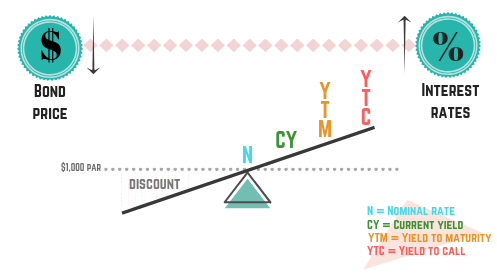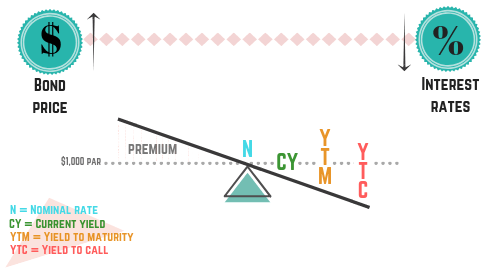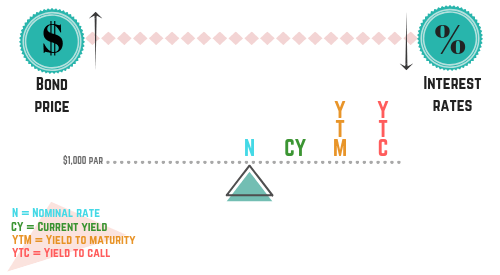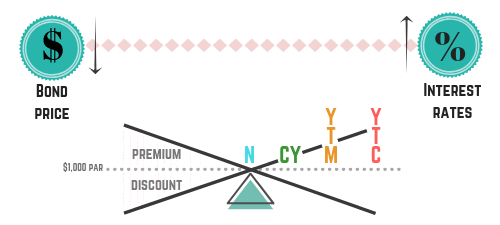Let’s look at a summary of our discount bond example from the previous sections.
A 10 year, $1,000 par, 4% bond is trading at $800. The bond is callable at par after 5 years.
Coupon = 4%
Current yield = 5%
YTM = 6.7%
YTC = 8.9%
The order of these yields is no coincidence. In fact, every discount bond will exhibit the same relationship between the yields. The coupon will be the lowest rate, followed by the current yield, then the YTM, and last the YTC. You could spend time calculating each yield separately, or you can utilize a beloved visual with bonds: the bond see-saw.

As you can see, the bond see-saw is a quick way of determining the relationship between a bond’s price and its yields. Many test-takers commit the bond see-saw to memory and write it out on their scratch paper when they take the exam. By doing this, you can avoid doing most of the calculations we just went through.
NASAA is more concerned that you know the relationship between the yields (which is lower or higher) than your ability to calculate these yields. While you certainly can be required to calculate current yield, the order of the yields and their relationships are more important topics to master. Plus, knowing the order of yields will help you eliminate wrong answers to yield calculation questions.
Let’s continue using our premium bond example from the previous sections.
A 10 year, $1,000 par, 4% bond is trading at $1,100. The bond is callable at par after 5 years.
Coupon = 4%
Current yield = 3.6%
YTM = 2.9%
YTC = 1.9%
Again, the order of these yields is no coincidence. In fact, every premium bond will exhibit the same relationship between the yields. The YTC will be the lowest rate, followed by the YTM, then the current yield, and last the coupon. You could spend time calculating each yield separately, or you can utilize the bond see-saw.

As we witnessed with discount bonds, the bond see-saw gives us a great visual representation of the yields. Now, we have the price side pointed upward, as premium bonds are purchased at prices above par. Remember the specific order of the yields on the see-saw and yield-based questions will be easy to answer!
We’ve gone through how prices affect yields for bonds purchased at discounts and premiums. What if a bond is purchased at par ($1,000)? We won’t need to go into much detail, because this concept is fairly simple. When a bond is purchased at par, all of the yields are equal to the coupon.
The investor isn’t making or losing any money through the purchase price of their bond. If the bond is bought at par ($1,000), it will mature at par ($1,000). The only return the investor is realizing is the coupon. For a bond purchased at its par value, the see-saw looks like this:

As you can see, the coupon is at the same level as the current yield, YTM, and YTC. If you see a question on par bond yields, keep it simple. All of them are the same.
Yield is a very important concept on the Series 7 exam, and hopefully, the bond see-saw helps visualize the relationship between bond prices, interest rate changes, and the yields. We’ve looked at the see-saw through the lens of a discount bond, premium bond, and par bond. Let’s take a look at all of them together:

If you’re going to utilize a “dump sheet,” it’s highly recommended that this be a part of it. A dump sheet is a list of visual items that are written out on your scratch paper after you start your exam. Many students memorize concepts like the bond see-saw in order to rewrite them for the exam and rely on it for yield questions.
I’ve also seen a lot of successful test-takers use acronyms, like this:
CYM Call
CY = Current Yield
M = yield to Maturity
Call = yield to Call
Whatever will help you commit these terms to memory is encouraged. It doesn’t matter how you remember it, as long as you remember it!
Two yields are typically provided when a bond quote is given to investors (and also disclosed on trade confirmations). First, the bond’s nominal yield (coupon) is disclosed, which provides insight into the security’s interest payments. Second, the bond’s yield to worst is furnished, which represents the lower of the YTM or YTC. Providing an investor with the worst of these two yields gives them a “worst-case scenario.” Let’s go through the two general scenarios.
If a callable bond is bought at a discount, the investor is provided the YTM. An investor would make a higher annualized return if a discount bond is redeemed sooner as they would earn the discount faster. For example, let’s assume a 20 year bond that is callable in 10 years at par is purchased for 90 ($900). The investor would earn the $100 discount faster if the bond is called before maturity, resulting in a higher annualized return. The YTM assumes the discount bond is held to maturity, which reflects the discount being gained slower and the lowest possible yield (unless the bond defaults).
If a callable bond is bought at a premium, the investor is provided the YTC. An investor would make a higher annualized return if a premium bond is held to maturity as they would lose the premium slower. For example, let’s assume a 20 year bond that is callable in 10 years at par is purchased for 110 ($1,100). The investor would lose the $100 premium slower if the bond is held to maturity, resulting in a higher annualized return. The YTC assumes the premium bond is called at the first possible date, which reflects the premium being lost faster and the lowest possible yield (unless the bond defaults).
No YTC exists if a bond is not callable. Therefore, the YTM is always provided when quoting a non-callable bond.
Assuming a bond is callable, here’s the “yield to worst” summary:
Sign up for free to take 10 quiz questions on this topic